Temperature Reconstruction in the Southern Margin of Taklimakan Desert from Tamarix Cones Using GWO-SVM Model
Abstract
1. Introduction
2. Investigated Area
3. Materials and Methods
3.1. Tamarix Cones Data
3.2. Methods
- (1)
- Neighborhood rough set model
- (2)
- Support vector machine optimized by grey wolf optimizer
- (3)
- Statistical analyses
4. Reconstruction of Annual Mean Temperature
4.1. The Correlation between the Climate Proxies and Their Relationships with Temperature
4.2. The Correlation between the Climate Proxies Groups and Their Relationships with Temperature
4.3. Proxies Selection
4.4. Establishment of the Model
5. Results and Discussion
5.1. Overall Change and Stage Division of Regional Annual Mean Temperature
5.2. Comparison with Other Temperature Reconstructions around the STD
6. Conclusions
- NRS is suitable for optimizing climate proxies with a cross redundancy.
- Utilizing the GWO-SVM model established in this paper, the annual mean temperature in STD can be conveniently and reasonably reconstructed using the climate proxies of Tamarix cones.
- The annual mean temperature in STD has distinct stages during the period from 1790 to 2010 AD, with cold conditions during 1790–1840 AD and 1896–1939 AD, and with warm conditions during 1841–1895 AD and 1940–2010 AD.
Author Contributions
Funding
Institutional Review Board Statement
Informed Consent Statement
Data Availability Statement
Conflicts of Interest
References
- Wang, X.; Sun, D.; Wang, F.; Li, B.; Wu, S.; Guo, F.; Li, Z.; Zhang, Y.; Chen, F. A high-resolution multi-proxy record of late Cenozoic environment change from central Taklimakan Desert, China. Clim. Past 2013, 9, 2731–2739. [Google Scholar] [CrossRef]
- Muhtar, Q.; Hiroki, T.; Mijit, H. Formation and internal structure of Tamarix cones in the Taklimakan Desert. J. Arid Environ. 2002, 50, 81–97. [Google Scholar]
- Xia, X.; Zhao, Y.; Wang, F.; Cao, Q.; Mu, G.; Zhao, J. Stratification features of Tamarix Cone and its possible significance. Chin. Sci. Bull. 2004, 13, 1337–1338. (In Chinese) [Google Scholar] [CrossRef]
- Xia, X.; Zhao, Y.; Wang, F.; Cao, Q. Environmental significance exploration to Tamarix Cone age layer in Lop Nur Lake region. Chin. Sci. Bull. 2005, 19, 130–131. (In Chinese) [Google Scholar]
- Wang, Y.; Zhao, Y. Pollen assemblages of Tamarix Cone and vegetation and climatic change in the Lop Nur region during the past about 200 years. Quat. Sci. 2010, 30, 609–619. (In Chinese) [Google Scholar]
- Zhang, J.; Yao, T.; Liu, C.; Liu, S.; Sun, T.; Yuan, H.; Tang, J.; Ding, F.; Li, X.; Liu, R.; et al. Climate environmental change and stable carbon isotopes in age layers of Tamarix sand-hillocks in Kumtag desert. Acta Ecol. Sin. 2014, 34, 943–952. (In Chinese) [Google Scholar]
- Cui, X.; Feng, Q.; Wang, X. Characteristics and simulation analysis of evapotranspiration of shrub sand dune at the oasis-desert transitional zones. Sci. Soil Water Conserv. 2007, 5, 44–48. (In Chinese) [Google Scholar]
- Dong, Z.W.; Umut, H.; Li, S.Y.; Lei, J.Q.; Zhao, Y. Soil stoichiometric characteristics of Tamarisk cones in the Southwest margin of Gurbantunggut Desert. Acta Ecol. Sin. 2020, 40, 7389–7400. (In Chinese) [Google Scholar]
- Zhang, S. The Preferred Application of Environmental Proxies of Tamarix Cone in Environmental Change Research in the Southern Source of the Taklimakan Desert. Master Dissertation, (In Chinese). Hebei Normal University, Shijiazhuang, China, 2019. [Google Scholar]
- Zhang, J.; Liu, C.; Yao, T.; Sun, T.; Guo, T.; Guo, C.; Yuan, H.; Tang, J.; Ding, F.; Li, X.; et al. Exploration to sedimentary environment and grain-size characteristics in age layers of Tamarix sand-hillocks in Kumtag Desert. Arid. Land Geogr. 2014, 37, 1155–1162. (In Chinese) [Google Scholar]
- Zhang, Z.; Ullah, I.; Wang, Z.; Ma, P.; Zhao, Y.; Xia, X.; Li, Y. Reconstruction of temperature for the past 400 years in the southern margin of the Taklimakan Desert based on carbon isotope fractionation of Tamarix leaves. Appl. Ecol. Environ. Res. 2019, 17, 271–284. [Google Scholar] [CrossRef]
- Liu, B.; Liu, H.; Mu, Y.; Li, G.; He, Y.; Zhuang, L. Correlation between the Stable Carbon Isotopes in Annual Layers ofTamarix ramosissima Sand-hillocks in the Lower Reaches of the Tarim River. Arid. Zone Res. 2018, 35, 728–734. (In Chinese) [Google Scholar]
- Dong, Z.; Mao, D.; Ye, M.; Li, S.; Ma, X.; Liu, S. Fractal features of soil grain-size distribution in a typical Tamarix Cones in the Taklimakan Desert, China. Sci. Rep. 2022, 12, 16461. [Google Scholar] [CrossRef] [PubMed]
- Zhang, Z.; Fang, Y.; Li, L.; Sun, Z.; Zhao, Y.; Xia, X.; Ashraf, M. Reconstruction of the paleotemperature in the southern margin of the Taklimakan Desert based on carbon isotope discrimination of Tamarix leaves. Appl. Ecol. Environ. Res. 2017, 15, 561–570. [Google Scholar] [CrossRef]
- Sarzaeim, P.; Bozorg-Haddad, O.; Bozorgi, A.; Loaiciga, H.A. Runoff projection under climate change conditions with data-mining methods. J. Irrig. Drain. Eng. 2017, 143, 04017026.1–04017026.7. [Google Scholar] [CrossRef]
- Abubakar, A.; Chiroma, H.; Zeki, A. Utilising key climate element variability for the prediction of future climate change using a support vector machine model. Int. J. Glob. Warm. 2016, 9, 129–151. [Google Scholar] [CrossRef]
- Zhang, B.; Zhang, L.; Xie, D. Application of Synthetic NDVI Time Series Blended from Landsat and MODIS Data for Grassland Biomass Estimation. Remote Sens. 2016, 8, 10. [Google Scholar] [CrossRef]
- Daliman, S.; Rahman, S.; Bakar, S. Segmentation of oil palm area based on GLCM-SVM and NDVI. In Proceedings of the Region 10 Symposium IEEE, Kuala Lumpur, Malaysia, 14–16 April 2014. [Google Scholar]
- Zhao, Y.; Liu, H.; Che, G.; Wang, H.; Gao, C.; Xia, X. On age sequence establishment method of Tamarix Cone sedimentary veins in Desert region. Arid Zone Res. 2015, 32, 810–817. (In Chinese) [Google Scholar]
- Shen, J.; Wang, Y.; Liu, X. A 16 ka climate record deduced from δ13C and C/N ratio in Qinghai Lake sediments, northeastern Tibetan Plateau. Chin. J. Ocean. Limnol. 2006, 24, 103–110. [Google Scholar]
- Zhang, H.; Ma, Y.; Wünnemann, B.; Pachur, H. A Holocene climatic record from arid northwestern China. Palaeogeogr. Palaeoclimatol. Palaeoecol. 2000, 162, 389–401. [Google Scholar] [CrossRef]
- Espeleta, J.; Cardon, Z.; Mayer, K.; Neumann, R. Diel plant water use and competitive soil cation exchange interact to enhance NH4+ and K+ availability in the rhizosphere. Plant Soil 2017, 414, 415–416. [Google Scholar] [CrossRef]
- Lucas, R.W.; Sponseller, R.A.; Laudon, H. Controls Over Base Cation Concentrations in Stream and River Waters: A Long-Term Analysis on the Role of Deposition and Climate. Ecosystems 2013, 16, 707–721. [Google Scholar] [CrossRef]
- Churakova-Sidorova, O.; Myglan, V.; Fonti, M.; Naumova, O.; Kirdyanov, A.; Kalugin, I.; Babich, V.; Falster, G.; Vaganov, E.; Siegwolf, R.; et al. Modern aridity in the Altai-Sayan mountain range derived from multiple millennial proxies. Sci. Rep. 2022, 12, 7752. [Google Scholar] [CrossRef]
- Zhang, R.; Qin, L.; Shang, H.; Yu, S.; Gou, X.; Mambetov, B.; Bolatov, K.; Zheng, W.; Ainur, U.; Bolatova, A. Climatic change in southern Kazakhstan since 1850 C.E. inferred from tree rings. Int. J. Biometeorol. 2020, 64, 841–851. [Google Scholar] [CrossRef]
- Chen, Y.; Xue, Y.; Ma, Y.; Xu, F. Measures of uncertainty for neighborhood rough sets. Knowl.-Based Syst. 2017, 120, 226–235. [Google Scholar] [CrossRef]
- Li, W.; Huang, Z.; Jia, X.; Cai, X. Neighborhood-based decision-theoretic rough-set models. Acoust. Bull. 2016, 69, 1–17. [Google Scholar] [CrossRef]
- Zhang, J.; Li, T.; Ruan, D.; Liu, D. Neighborhood rough sets for dynamic data mining. Int. J. Intell. Syst. 2012, 27, 317–342. [Google Scholar] [CrossRef]
- Hu, Q.; Yu, D.; Liu, J.; Wu, C. Neighborhood rough-set-based heterogeneous feature subset selection. Inf. Sci. 2008, 178, 3577–3594. [Google Scholar] [CrossRef]
- Zhou, J.; Huang, S.; Wang, M.; Qiu, Y. Performance evaluation of hybrid GA-SVM and GWO-SVM models to predict earthquake-induced liquefaction potential of soil: A multi-dataset investigation. Eng. Comput. 2022, 38, 4197–4215. [Google Scholar] [CrossRef]
- Zhou, Z.; Zhang, R.; Wang, Y. Color difference classification based on optimization support vector machine of improved grey wolf algorithm. Optik 2018, 170, 17–29. [Google Scholar] [CrossRef]
- Hou, K.; Shao, G.; Wang, H. Research on practical power system stability analysis algorithm based on modified SVM. Prot Control Mod. Power Syst. 2018, 3, 11. [Google Scholar] [CrossRef]
- Emile-Geay, J.; Tingley, M. Inferring climate variability from nonlinear proxies: Application to palaeo-ENSO studies. Clim. Past 2015, 11, 31–50. [Google Scholar] [CrossRef]
- Bauwens, M.; Ohlsson, H.; Barbé, K.; Beelaerts, V.; Dehairs, F.; Schoukens, J. On climate reconstruction using bivalves: Three methods to interpret the chemical signature of a shell. Comput. Methods Programs Biomed. 2011, 104, 104–111. [Google Scholar] [CrossRef]
- Zhang, Z.; Wagner, S.; Klockmann, M.; Zorita, E. Evaluation of statistical climate reconstruction methods based on pseudoproxy experiments using linear and machine-learning methods. Clim. Past 2022, 18, 2643–2668. [Google Scholar] [CrossRef]
- Kaufmann, G.; Dreybrodt, W. Stalagmite growth and palaeo-climate: An inverse approach. Earth Planet. Sci. Lett. 2004, 224, 529–545. [Google Scholar] [CrossRef]
- Liu, Y.; Sun, C.; Li, Q.; Cai, Q. A Picea crassifolia tree-ring width-based temperature reconstruction for the Mt. Dongda region, Northwest China, and its relationship to large-scale climate forcing. PLoS ONE 2016, 11, e0160963. [Google Scholar] [CrossRef] [PubMed]
- Rydval, M.; Loader, N.; Gunnarson, B.; Druckenbrod, D.; Linderholm, H.; Moreton, S.; Wood, C.; Wilson, R. Reconstructing 800 years of summer temperatures in Scotland from tree rings. Clim. Dynam. 2017, 49, 2951–2974. [Google Scholar] [CrossRef]
- Fan, M.; Xu, J.; Yu, W.; Chen, Y.; Wang, M.; Dai, W.; Wang, Y. Recent Tianshan warming in relation to large-scale climate teleconnections. Sci. Total Environ. 2023, 856, 159–201. [Google Scholar] [CrossRef]
- Hu, R.; Jiang, F.; Wang, Y.; Fang, Z. A study on signals and effects of climatic pattern change from warm-dry to warm-wet in Xinjiang. Arid Land Geogr. 2002, 3, 194–200. (In Chinese) [Google Scholar]
- Wang, Y.; Feng, Q.; Kang, X. Tree-ring-based reconstruction of temperature variability (1445–2011) for the upper reaches of the Heihe River Basin, Northwest China. J. Arid Land 2016, 8, 60–76. [Google Scholar] [CrossRef]
- Zhang, Y.; Li, J.; Wang, S.; Shao, X.; Qin, N.; An, W. A reconstruction of June–July temperature since AD 1383 for Western Sichuan Plateau, China using tree-ring width. Int. J. Climatol. 2022, 42, 1803–1817. [Google Scholar] [CrossRef]
- Liang, E.; Shao, X.; Qin, N. Tree-ring based summer temperature reconstruction for the source region of the Yangtze River on the Tibetan Plateau. Glob. Planet. Chang. 2008, 61, 313–320. [Google Scholar] [CrossRef]
- Wang, C.; Hu, Y. Analysis on the characteristics of cold-warm climate variations since recent 250 year in Yili region, Xinjiang, China. Arid Land Geogr. 1996, 19, 37–44. (In Chinese) [Google Scholar]
- Wang, J.; Yang, B.; Ljungqvist, F. A millennial summer temperature reconstruction for the Eastern Tibetan Plateau from tree-ring width. J. Clim. 2015, 28, 5289–5304. [Google Scholar] [CrossRef]
- Shi, Y.; Yao, T.; Yang, B. The comparison between the 10a-scale climatic records from the Guliya ice core since last 2ka and historic documents in eastern China. Sci. China Ser. D (In Chinese). 1999, 29 (Suppl. 1), 79–86. [Google Scholar]
- Zhang, X.; Yao, T.; Shi, W.; Li, Z. Record of climate change since Little Ice Age in the ice core of the Guliya ice cap. J. Nat. Sci. Hunan Norm. Univ. 1999, 22, 80–84. (In Chinese) [Google Scholar]
- Wang, J. Study on regional climate response to global warming in the arid central-east asia over the past 100 years. Ph.D. Thesis, Lanzhou University, Lanzhou, China, 2006. (In Chinese). [Google Scholar]
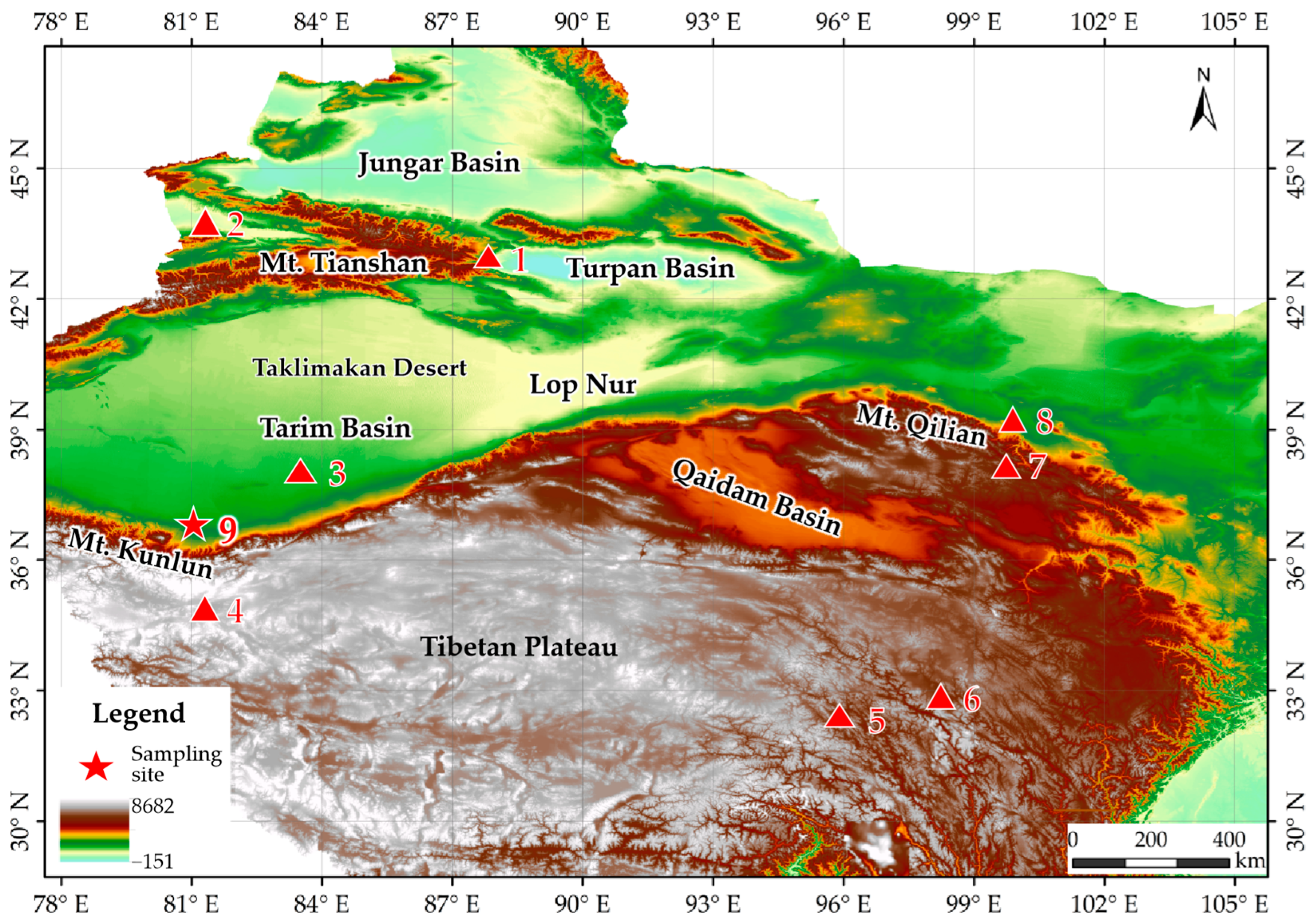
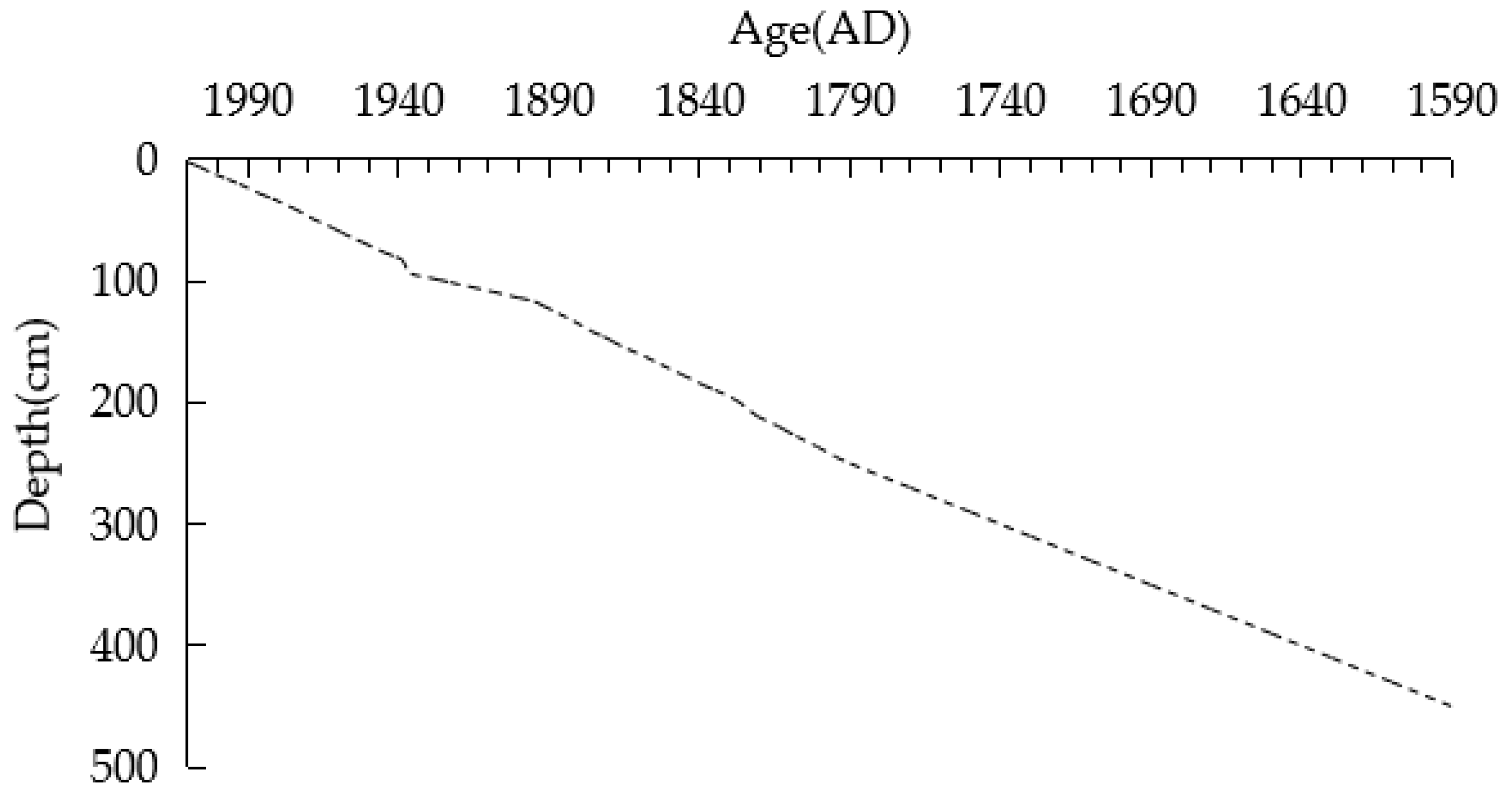

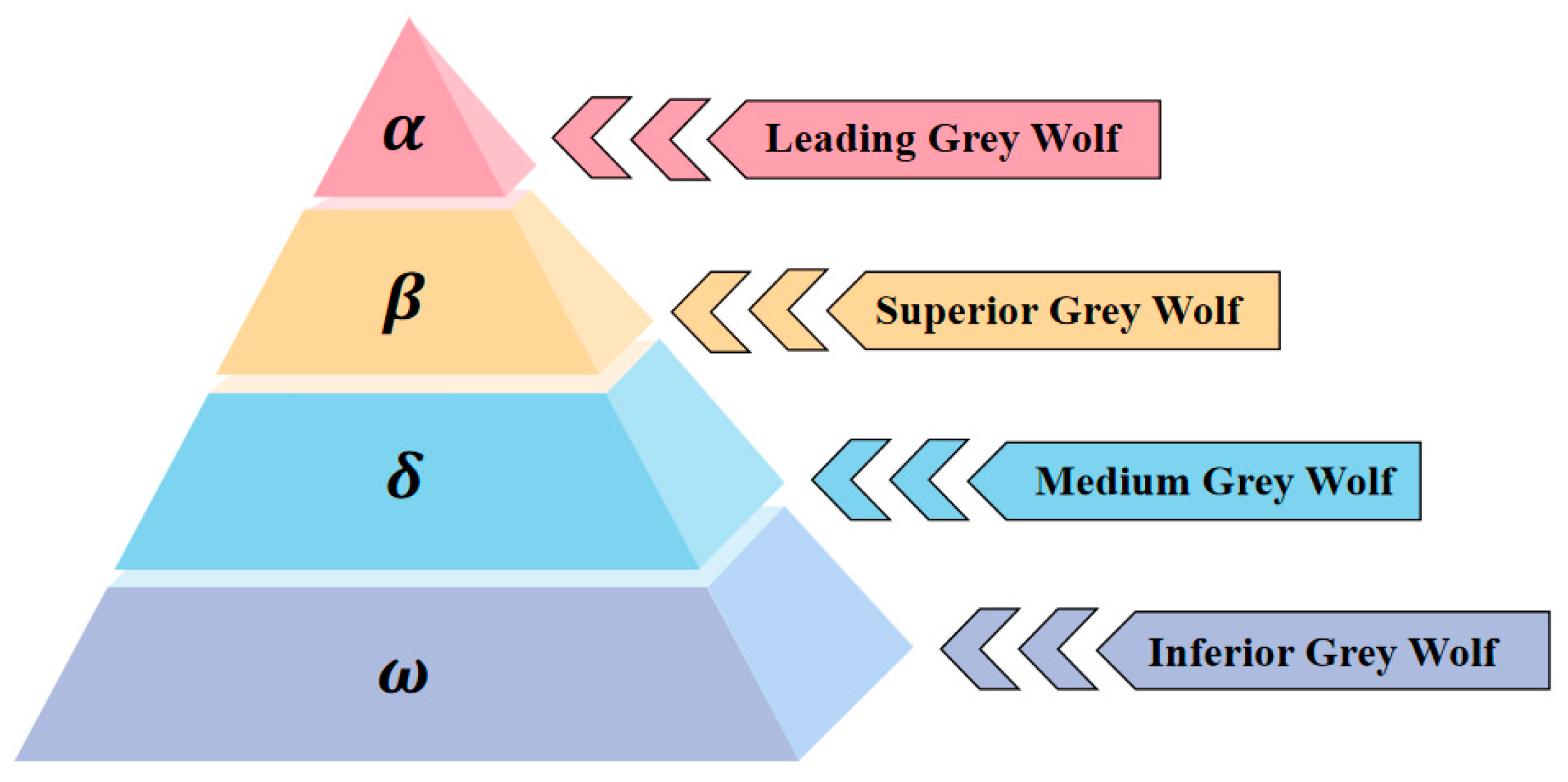
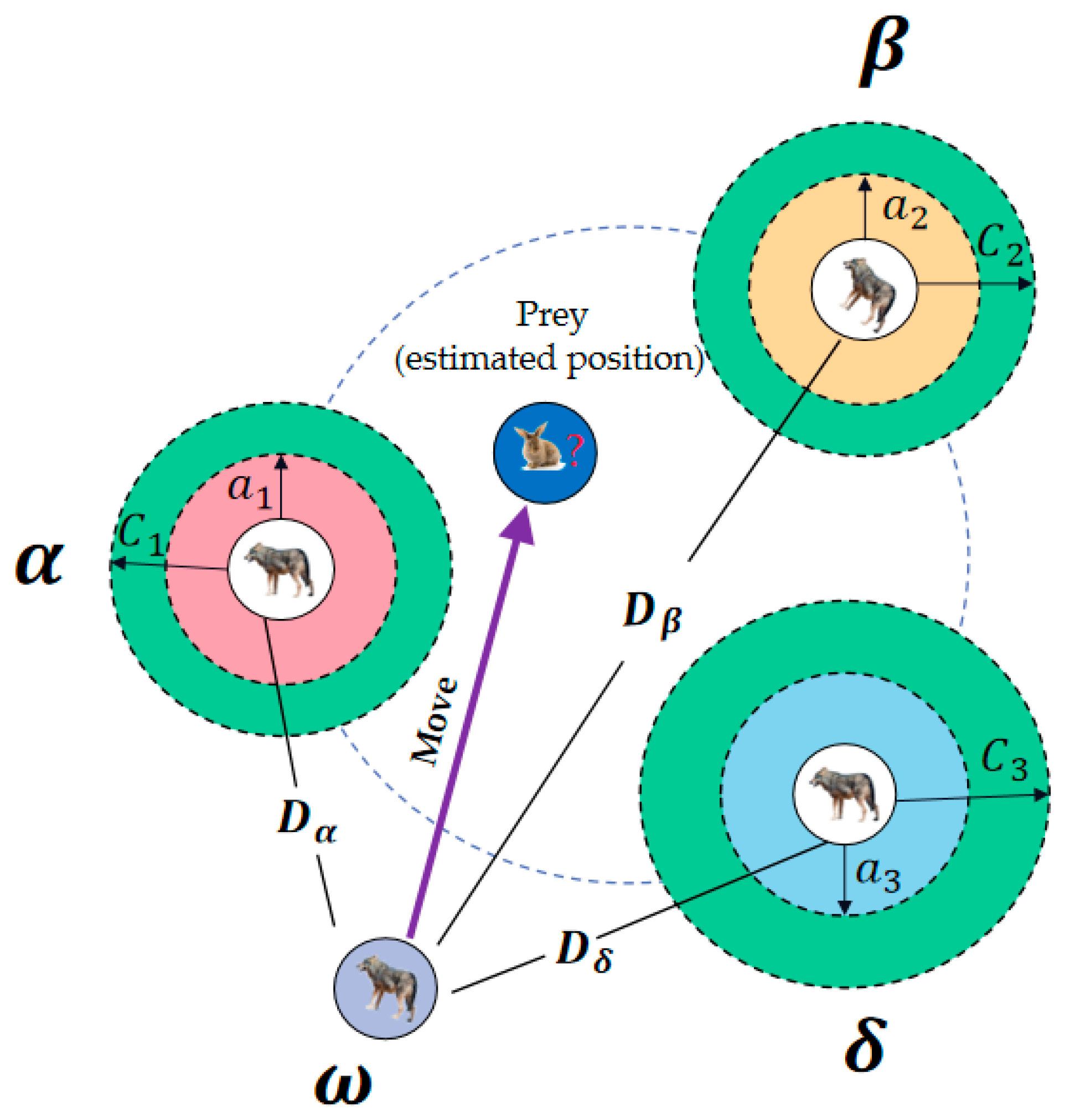
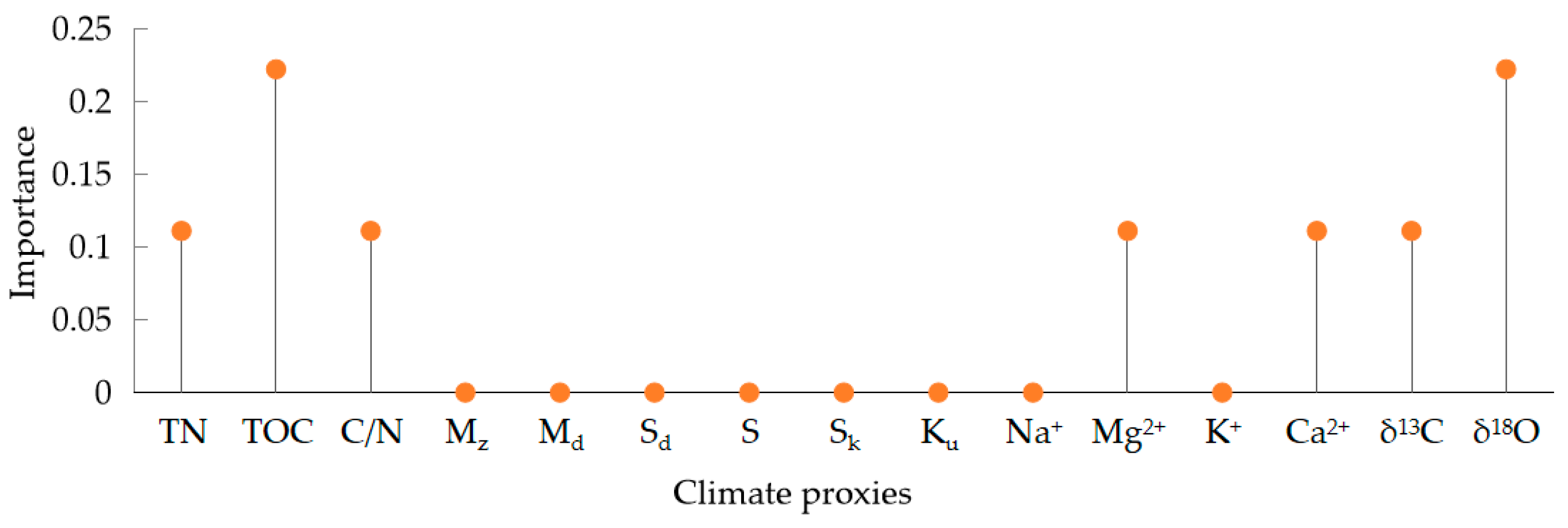


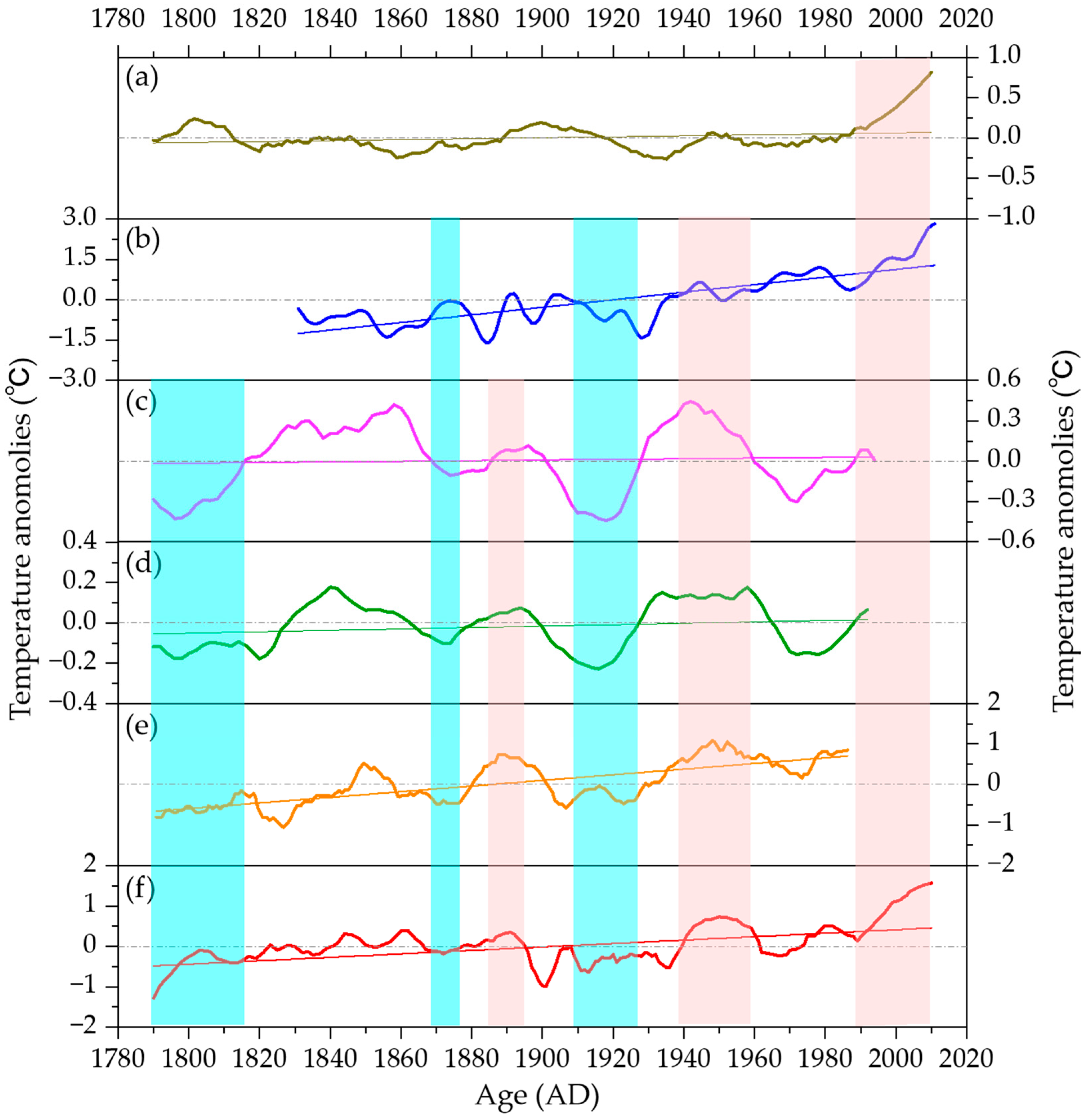
| Climate Proxies Group | Single Proxy |
|---|---|
| Organic matter content of Tamarix cones | Total nitrogen (TN) Total organic carbon (TOC) Carbon–nitrogen ratio (C/N) |
| Grain size of Tamarix cones | Average grain size (Mz), Median grain size (Md) Sorting coefficient (Sd), Standard deviation (S) Skewness (Sk), Kurtosis (Ku) |
| Cation content of Tamarix cones | Na+, Mg2+, K+, Ca2+ |
| Stable isotopic content of Tamarix cones | δ13C, δ18O |
| TN | TOC | C/N | Mz | Md | Sd | S | Sk | Ku | Na+ | Mg2+ | K⁺ | Ca2+ | δ13C | δ18O | Temp. | |
|---|---|---|---|---|---|---|---|---|---|---|---|---|---|---|---|---|
| TN | 1 | - | - | - | - | - | - | - | - | - | - | - | - | - | - | - |
| TOC | 0.11 | 1 | - | - | - | - | - | - | - | - | - | - | - | - | - | - |
| C/N | −0.89 ** | 0.21 | 1 | - | - | - | - | - | - | - | - | - | - | - | - | - |
| Mz | −0.19 | 0.05 | 0.21 | 1 | - | - | - | - | - | - | - | - | - | - | - | - |
| Md | −0.17 | 0.05 | 0.20 | 0.99 ** | 1 | - | - | - | - | - | - | - | - | - | - | - |
| Sd | −0.59 ** | −0.24 | 0.47 ** | 0.18 | 0.16 | 1 | - | - | - | - | - | - | - | - | - | - |
| S | 0.53 ** | 0.15 | −0.45* | −0.73 ** | −0.71 ** | −0.79 ** | 1 | - | - | - | - | - | - | - | - | - |
| Sk | 0.05 | −0.07 | −0.08 | −0.91 ** | −0.90 ** | 0.09 | 0.54 ** | 1 | - | - | - | - | - | - | - | - |
| Ku | −0.47 ** | −0.14 | 0.41 * | 0.61 ** | 0.59 ** | 0.67 ** | −0.89 ** | −0.54 ** | 1 | - | - | - | - | - | - | - |
| Na+ | −0.09 | 0.37 | 0.33 | −0.10 | −0.10 | −0.01 | 0.06 | 0.06 | 0.06 | 1 | - | - | - | - | - | - |
| Mg2+ | 0.30 | 0.01 | −0.19 | −0.06 | −0.05 | −0.32 | 0.22 | −0.1 | −0.02 | 0.57 ** | 1 | - | - | - | - | - |
| K⁺ | 0.35 | 0.31 | −0.15 | −0.16 | −0.15 | −0.38 * | 0.36 | 0.03 | −0.24 | 0.74 ** | 0.84 ** | 1 | - | - | - | - |
| Ca2+ | −0.18 | −0.16 | 0.14 | 0.29 | 0.30 | 0.32 | −0.42 * | −0.24 | 0.46 * | 0.07 | 0.43 * | 0.15 | 1 | - | - | - |
| δ13C | −0.30 | 0.32 | 0.38 * | 0.08 | 0.09 | 0.23 | −0.13 | 0.13 | −0.11 | −0.10 | −0.34 | −0.23 | −0.04 | 1 | - | - |
| δ18O | 0.03 | 0.42 * | 0.13 | −0.15 | −0.15 | −0.03 | 0.08 | 0.08 | 0.07 | 0.39 * | 0.23 | 0.21 | 0.06 | −0.16 | 1 | - |
| Temp. | −0.26 | −0.12 | 0.15 | 0.24 | 0.24 | 0.36 | −0.42 * | −0.16 | 0.38 * | −0.34 | −0.51 ** | −0.63 ** | 0.06 | 0.12 | −0.11 | 1 |
| Correlation Coefficient | Significance | |
|---|---|---|
| Organic matter content vs. Grain size | 0.661 | 0.521 |
| Organic matter content vs. Cation content | 0.721 | 0.002 ** |
| Grain size vs. Cation content | 0.774 | 0.031 * |
| Correlation Coefficient | Significance | |
|---|---|---|
| Organic matter content | 0.313 | 0.454 |
| Grain size | 0.748 | 0.003 ** |
| Cation content | 0.674 | 0.004 ** |
| Stable isotopic content | 0.310 | 0.001 ** |
Disclaimer/Publisher’s Note: The statements, opinions and data contained in all publications are solely those of the individual author(s) and contributor(s) and not of MDPI and/or the editor(s). MDPI and/or the editor(s) disclaim responsibility for any injury to people or property resulting from any ideas, methods, instructions or products referred to in the content. |
© 2023 by the authors. Licensee MDPI, Basel, Switzerland. This article is an open access article distributed under the terms and conditions of the Creative Commons Attribution (CC BY) license (https://creativecommons.org/licenses/by/4.0/).
Share and Cite
Li, Z.; Wang, Z.; Cui, C.; Zhang, S.; Zhao, Y. Temperature Reconstruction in the Southern Margin of Taklimakan Desert from Tamarix Cones Using GWO-SVM Model. Sustainability 2023, 15, 10813. https://doi.org/10.3390/su151410813
Li Z, Wang Z, Cui C, Zhang S, Zhao Y. Temperature Reconstruction in the Southern Margin of Taklimakan Desert from Tamarix Cones Using GWO-SVM Model. Sustainability. 2023; 15(14):10813. https://doi.org/10.3390/su151410813
Chicago/Turabian StyleLi, Zhiguang, Zitong Wang, Can Cui, Shuo Zhang, and Yuanjie Zhao. 2023. "Temperature Reconstruction in the Southern Margin of Taklimakan Desert from Tamarix Cones Using GWO-SVM Model" Sustainability 15, no. 14: 10813. https://doi.org/10.3390/su151410813
APA StyleLi, Z., Wang, Z., Cui, C., Zhang, S., & Zhao, Y. (2023). Temperature Reconstruction in the Southern Margin of Taklimakan Desert from Tamarix Cones Using GWO-SVM Model. Sustainability, 15(14), 10813. https://doi.org/10.3390/su151410813







